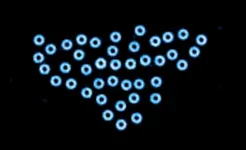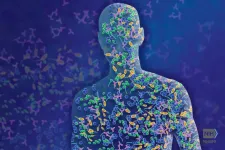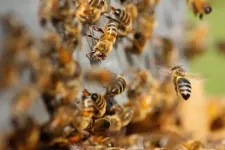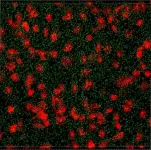High-resolution microscope built from LEGO and bits of phone
Research led by Göttingen University shows constructing microscope improves children's understanding
2021-06-23
(Press-News.org) Microscopy is an essential tool in many fields of science and medicine. However, many groups have limited access to this technology due to its cost and fragility. Now, researchers from the Universities of Göttingen and Münster have succeeded in building a high-resolution microscope using nothing more than children's plastic building bricks and affordable parts from a mobile phone. They then went on to show that children aged 9-13 had significantly increased understanding of microscopy after constructing and working with the LEGO® microscope. Their results were published in The Biophysicist.
The researchers designed a fully functional, high-resolution microscope with capabilities close to a modern research microscope. Apart from the optics, all parts were from the toy brick system. The team realized that the lenses in modern smartphone cameras, which cost around €4 each, are of such high quality that they can make it possible to resolve even individual cells. The scientists produced instructions for building the microscope as well as a step-by-step tutorial to guide people through the construction process whilst learning about the relevant optical characteristics of a microscope. The researchers measured children's understanding through questionnaires given to a group of 9-13 year olds. The researchers found that children given the parts and plans to construct the microscope themselves significantly increased their knowledge of microscopy. For this particular study, the researchers, whose day-to-day research focusses on fundamental biophysical processes, benefitted from the input and enthusiasm of their 10-year-old co-author.
"An understanding of science is crucial for decision-making and brings many benefits in everyday life, such as problem-solving and creativity," says Professor Timo Betz, University of Göttingen. "Yet we find that many people, even politicians, feel excluded or do not have the opportunities to engage in scientific or critical thinking. We wanted to find a way to nurture natural curiosity, help people grasp fundamental principles and see the potential of science." The researchers stayed in contact with the children and monitored their progress: after they had constructed the main parts, they discovered that the lenses can act as magnifying glasses. After exploring this, and realizing that a good light source was important, they initially found it tricky to align two magnifying glasses. However, once they had achieved this, the lenses generated tremendous magnification. This enabled the children to literally "play" with the microscope: make their own adaptations; explore how the magnification works; and discover the exciting world of the micro-cosmos for themselves.
"We hope that this modular microscope will be used in classrooms and homes all over the world to excite and inspire children about science," continues Betz. "We have shown that scientific research does not need to be separate from everyday life. It can be enlightening, educational and fun!"
INFORMATION:
All plans and instructions are available in English, German, Dutch and Spanish. They are free to access here: https://github.com/tobetz/LegoMicroscope
Original publication: Timo Betz et al, "Designing a high-resolution, LEGO-based microscope for an educational setting", The Biophysicist 2021, Doi: 10.35459/tbp.2021.000191, text also available here
Contact:
Professor Timo Betz
University of Göttingen
Faculty of Physics
Friedrich-Hund-Platz 1, 37077 Göttingen, Germany
Tel: +49 551 39 26921
Email: timo.betz@phys.uni-goettingen.de
http://www.betzlab.uni-goettingen.de/
[Attachments] See images for this press release:

ELSE PRESS RELEASES FROM THIS DATE:
2021-06-23
New York, NY--June 23, 2021--A challenging frontier in science and engineering is controlling matter outside of thermodynamic equilibrium to build material systems with capabilities that rival those of living organisms. Research on active colloids aims to create micro- and nanoscale "particles" that swim through viscous fluids like primitive microorganisms. When these self-propelled particles come together, they can organize and move like schools of fish to perform robotic functions, such as navigating complex environments and delivering "cargo" to targeted locations.
A Columbia Engineering team led by Kyle Bishop, professor of chemical engineering, is at the forefront of studying and designing the dynamics of active colloids powered by chemical reactions ...
2021-06-23
A new study published in Nature Communications finds that piles of sand grains, even when undisturbed, are in constant motion. Using highly-sensitive optical interference data, researchers from the University of Pennsylvania and Vanderbilt University present results that challenge existing theories in both geology and physics about how soils and other types of disordered materials behave.
Most people only become aware of soil movement on hillsides when soil suddenly loses its rigidity, a phenomenon known as yield. "Say that you have soil on a hillside. Then, if there's an earthquake or it rains, this material that's apparently ...
2021-06-23
WHAT:
National Institutes of Health scientists and their collaborators have identified an internal communication network in mammals that may regulate tissue repair and inflammation, providing new insights on how diseases such as obesity and inflammatory skin disorders develop. The new research is published in Cell.
The billions of organisms living on body surfaces such as the skin of mammals--collectively called microbiota--communicate with each other and the host immune system in a sophisticated network. According to the study, viruses integrated in the host genome, remnants of previous infections called endogenous retroviruses, can control how the host immune system and the microbiota ...
2021-06-23
Beekeepers across the United States lost 45.5% of their managed honey bee colonies from April 2020 to April 2021, according to preliminary results of the 15th annual nationwide survey conducted by the nonprofit Bee Informed Partnership (BIP). These losses mark the second highest loss rate the survey has recorded since it began in 2006 (6.1 percentage points higher than the average annual loss rate of 39.4%). The survey results highlight the continuing high rates of honey bee colony turnover. The high loss rate was driven by both elevated summer and winter losses this year, with no clear progression toward improvement ...
2021-06-23
Those with power, such as the wealthy are more likely to blame others for having shortcomings and they are also less troubled by reports of inequality, according to recent research from the University of California San Diego's Rady School of Management.
The study published in END ...
2021-06-23
BROOKLYN, New York, Wednesday, June 23, 2021 -- Owing to their tunable properties, hydrogels comprising stimuli-sensitive polymers are among the most appealing molecular scaffolds because their versatility allows for applications in tissue engineering, drug delivery and other biomedical fields.
Peptides and proteins are increasingly popular as building blocks because they can be stimulated to self-assemble into nanostructures such as nanoparticles or nanofibers, which enables gelation -- the formation of supramolecular hydrogels that can trap water and small molecules. Engineers, to generate such smart biomaterials, are developing systems that can respond to a multitude of stimuli including heat. Although thermosensitive hydrogels are among widely ...
2021-06-23
Irvine, CA - June 23, 2021 - A new University of California, Irvine-led study finds that the persistence of a marker of chronic cellular stress, previously associated with neurodegenerative diseases such as amyotrophic lateral sclerosis (ALS) and frontotemporal dementia (FTD), also takes place in the brains of Huntington's disease (HD) patients.
Chronic cellular stress results in the abnormal accumulation of stress granules (SGs), which are clumps of protein and RNAs that gather in the cell. Prior to this study, published in the Journal of Clinical ...
2021-06-23
Boston, MA--Early in the COVID-19 pandemic, many African leaders implemented prevention measures such as lockdowns, travel bans, border closures, and school closures. While these efforts may have helped slow the spread of the virus on the continent and continue to be important for its containment, they inadvertently disrupted livelihoods and food systems and curtailed access to critical nutrition, health, and education services. A new series of studies by researchers from Harvard T.H. Chan School of Public Health and colleagues from the Africa Research, Implementation Science and Education (ARISE) Network finds that these disruptions may have serious ...
2021-06-23
AMES, Iowa -- A new study of small Iowa towns found that vulnerable populations within those communities face significantly more public health risks than statewide averages.
The study, published this week in PLOS ONE, a peer-reviewed open access journal, was led by Benjamin Shirtcliff, associate professor of landscape architecture at Iowa State University.
He focused on three Iowa towns - Marshalltown, Ottumwa and Perry - as a proxy for studying shifting populations in rural small towns, in particular how vulnerable populations in these towns ...
2021-06-23
Our planet is warming due to anthropogenic greenhouse gas emissions; but the warming differs from region to region, and it can also vary seasonally. Over the last four decades scientists have observed a persistent austral summer cooling on the eastern side of Antarctica. This puzzling feature has received world-wide attention, because it is not far away from one of the well-known global warming hotspots - the Antarctic Peninsula.
A new study published in the journal Science Advances by a team of scientists from the IBS Center for Climate Physics at Pusan National University in South Korea, Nanjing University of Information Science and Technology, NOAA Geophysical Fluid Dynamics Laboratory, University Corporation for Atmospheric Research, Ewha Womans University, and National Taiwan ...
LAST 30 PRESS RELEASES:
[Press-News.org] High-resolution microscope built from LEGO and bits of phone
Research led by Göttingen University shows constructing microscope improves children's understanding






